American Bombers Of WW2
Starting our course of events in the stormy skies of World War II, we are situated in the most discussed chapter of aviation history which was marked by the heroic roars of the bombers’ engines. Such an advancement, which took place amidst the technological revolution, gave birth to some of the great and powerful Bombers Of WW2 that people know to date.
Moreover, The iconic American names such as the B-17 Flying Fortress and the B-24 Liberator and the modern-looking twin-engine German bombers are not just war devices but symbols of innovation and perseverance. Join us as we navigate through the annals of World War II, uncovering the stories of famous aircraft such as the B-29 Superfortress, the two-engine bombers, and other planes that composed the structure of Allied and Axis air forces.
However, Throughout the flight of World War II aviation, we come across an assortment of aerial warriors: double-engined bombers that dominated the skies of Europe to the biplanes that signaled the beginning of the war. Additionally, among these, the names of WW2 American planes- B-17, B-24, B-25 Mitchell, B-26 Marauder, and B-29 Superfortress, vibe with a certain magnitude, each a tribute to the US’s industrial and technological strength.
These combat planes together with their Axis counterparts certainly operated in a mission-critical way as regards the shaping of the strategies and the outcomes of many battles. They conducted strategic bombing missions resulting in the enemy’s inability to sustain the war effort, and thereby, were a contributing factor to the Allies’ ultimate victory.
As we narrate the stories of these planes, we not only immortalize their contributions, but also guarantee that the courage and creativity of those who crafted, built, and flew them will remain remembered.
American Bombers Of World War Two: B-17 Flying Fortress
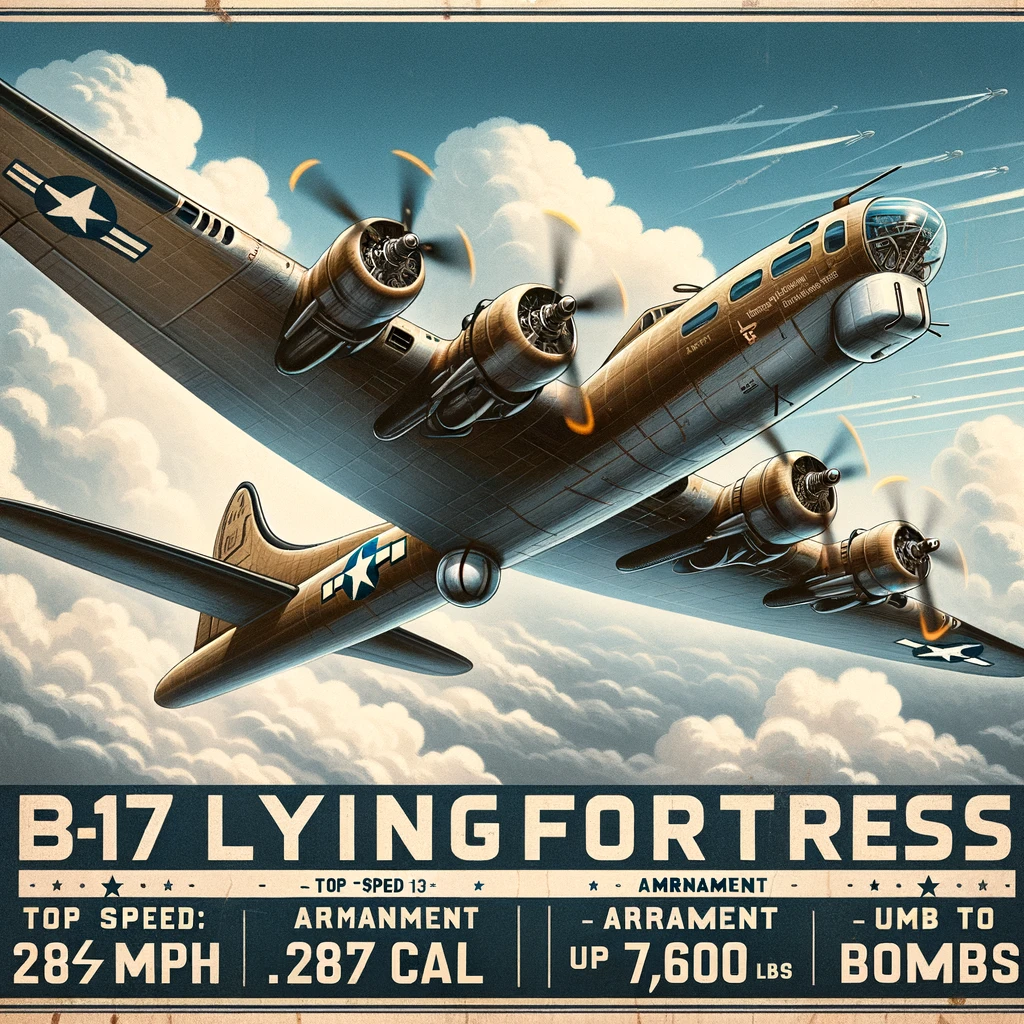
History and Production:
The Boeing B-17 Flying Fortress, known as one of the most iconic American bombers of WWII, had first successful flight in the year 1935, then after a wait of three years, it was introduced in service in the year 1938. Moreover, Its design was targeted to aim at the high-altitude strategic bombing with a high-caliber defensive armament. During this period there were more than 12,730 units produced.
Operational Achievements:
The B-17 succeed in delivering its best in the Daylight strategic bombing against Nazi Germany, by targeting & destroying their manufacturing plants, railroads, and airfields. But after a while, despite horrific losses, especially in the year 1943, when long-range aircraft like the P-51 Mustang were introduced. However, the value of its contribution to the Allied bombing campaigns is part of history.
Cost to Manufacture:
At first, a B-17 cost less than $238,329 per unit, which fluctuated throughout its production, depending on the new upgrades as well as manufacturing efficiency.
American Bombers Of World War Two: B-24 Liberator
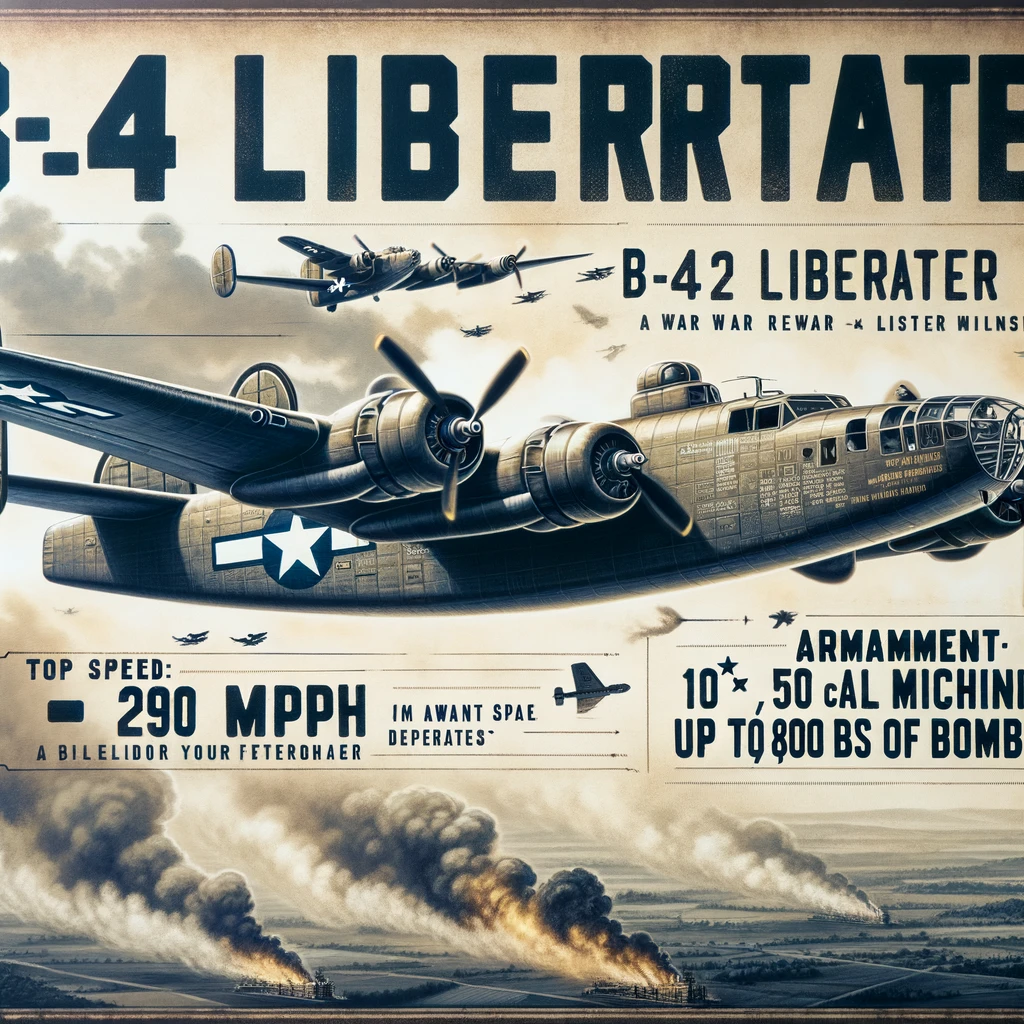
History and Production:
The long-range, high altitude, and large payload capabilities make the Consolidated B-24 Liberator famous. It made its first flight in 1939, and 18,482 units were produced during its production, making this model the most-produced U.S. military aircraft during the World War.
Operational Achievements:
The B-24 played a major role in the long-range missions that were executed in the Pacific, Europe, and African regions. August 1943 Mission, which was directed to destroy the Romanian oil fields, that got strategic importance to the Axis forces, was successful due to the capabilities of B-24 Liberator.
Cost to Manufacture:
The cost for one B-24 aircraft varied throughout its production, costing almost $297,627 per unit in 1945.
Why was the B-24 difficult to fly?
Flying the B-24 Liberator was difficult not an amusement park, and I will clearly explain to you why. More importantly, it was a little bit peculiar in its shape. B-24 featured a high-wing layout with a heavy load mounted on it, which caused it to respond to the commands of the flight crew a little more harshly than its counterparts.
The aircraft control would especially require the alertness of the pilot, during takeoff and landing, when the plane’s handling of air could be susceptible to being erratic. Additionally, the control surfaces were on the heavy side, emphasizing not only skilled management but also strength conservation.
Now add to that the complexity of running its system and the strive to operate in difficult conditions, and the plane which would be easily mastered only by the most diligent and self-confident pilots will appear. It was really a fantastic plane for its age, there is no doubt, but somehow it wanted to be careful with those flying it.
American Bombers Of WW2: B-25 Mitchell
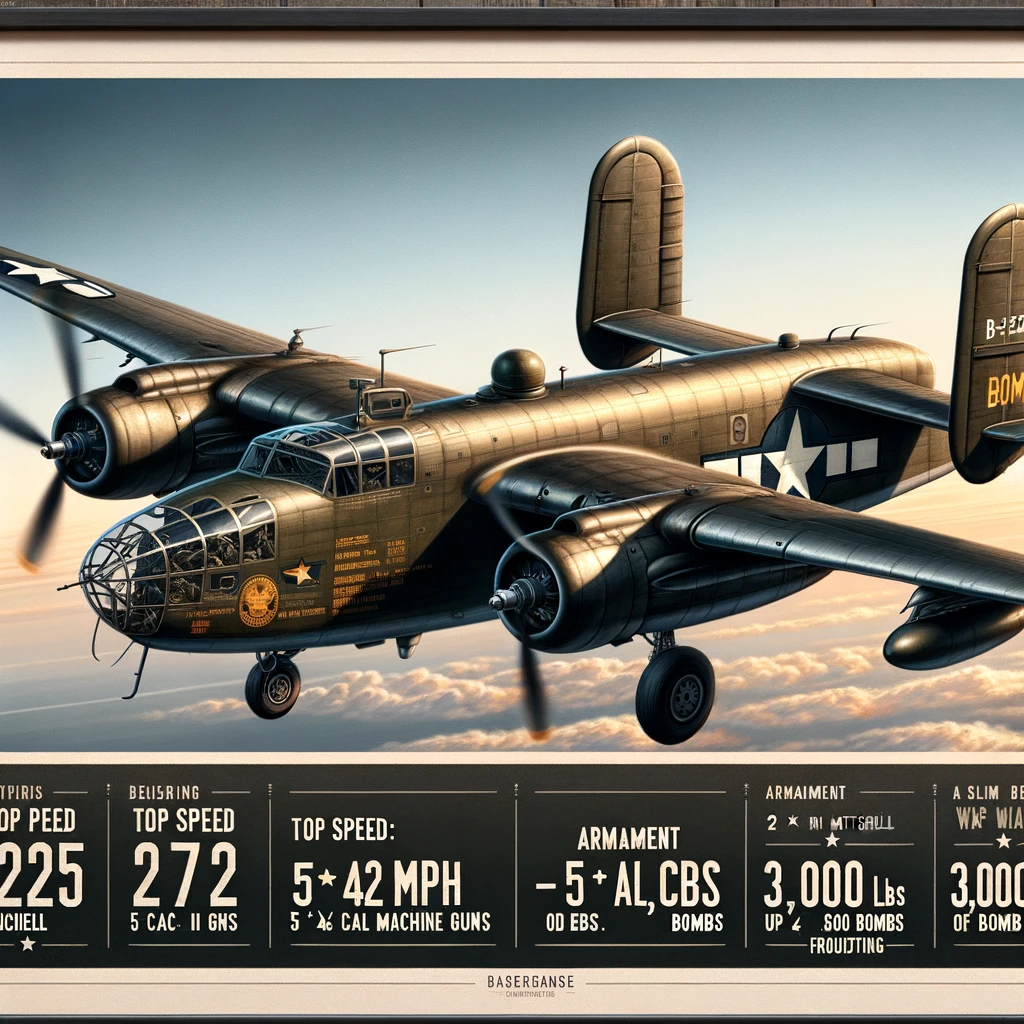
History and Production:
Named after Major General of that time William “Billy” Mitchell, the plane got its first flight in the year 1940, and 9,816 units were produced during its production. It became well known for the Doolittle Raids, one of which was the Tokyo 1942 bombardment, which presented the Americans’ determination to innovativeness.
Operational Achievements:
The B-25, which was involved in every theater of WWII was notable for its variety. It was adapted to perform various tasks, such as bombing and reconnaissance missions.
Cost to Manufacture:
The cost of every B-25 was equivalent to $142,194 in the year 1944.
American Bombers Of WW2: B-26 Marauder
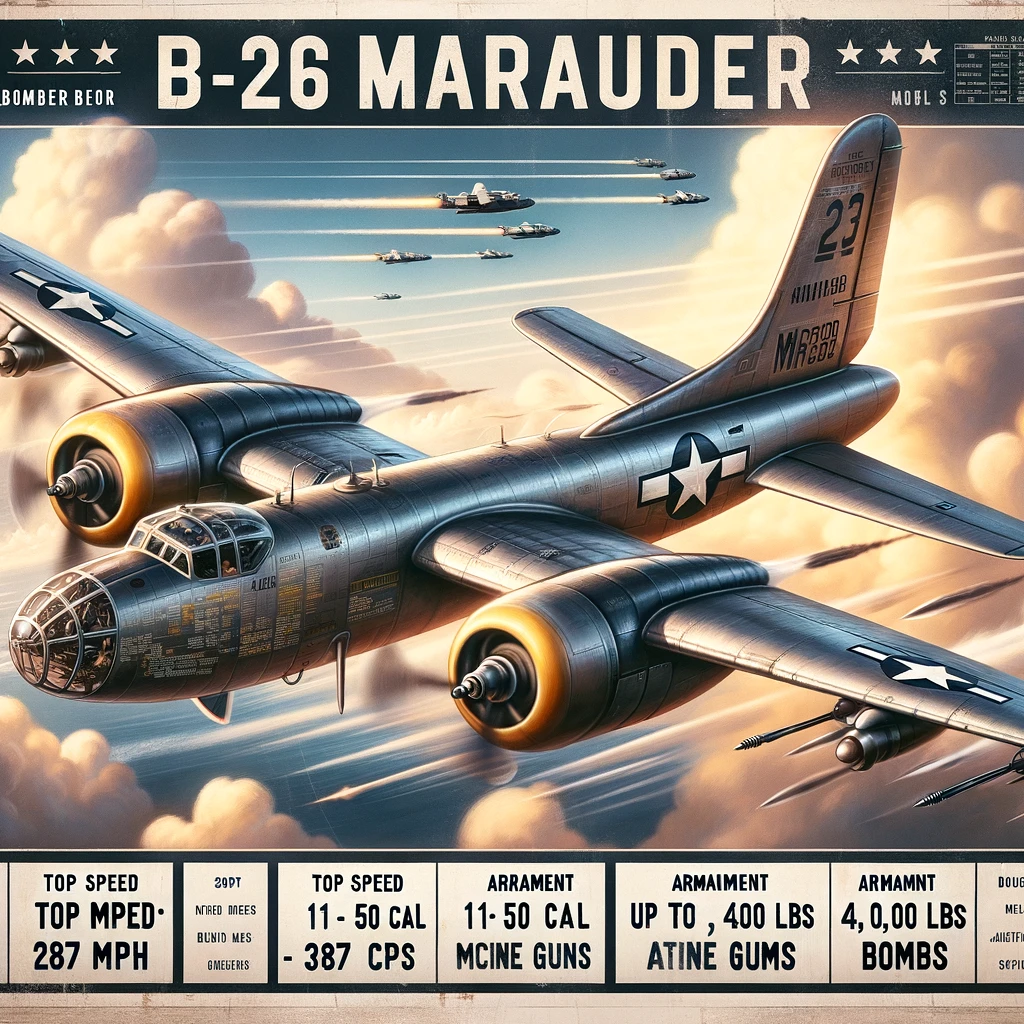
History and Production:
The Martin B-26 Marauder was a heavy bomber with a high-speed performance and was invented back in 1941. Despite the early technical problems, the Comet’s production reached 5,288 units during that time, which eventually became an important weapon that could be used in the European Battlegrounds.
Operational Achievements:
Furthermore, B-26 was considered to have the lowest mission failing percentage among all other U.S. bombers in WWII, which was a divine achievement in high-quality engineering and precision bombing capability.
Cost to Manufacture:
Each of these bombers cost around 192,426 Dollars at that time.
American Bombers Of WW2: B-29 Superfortress
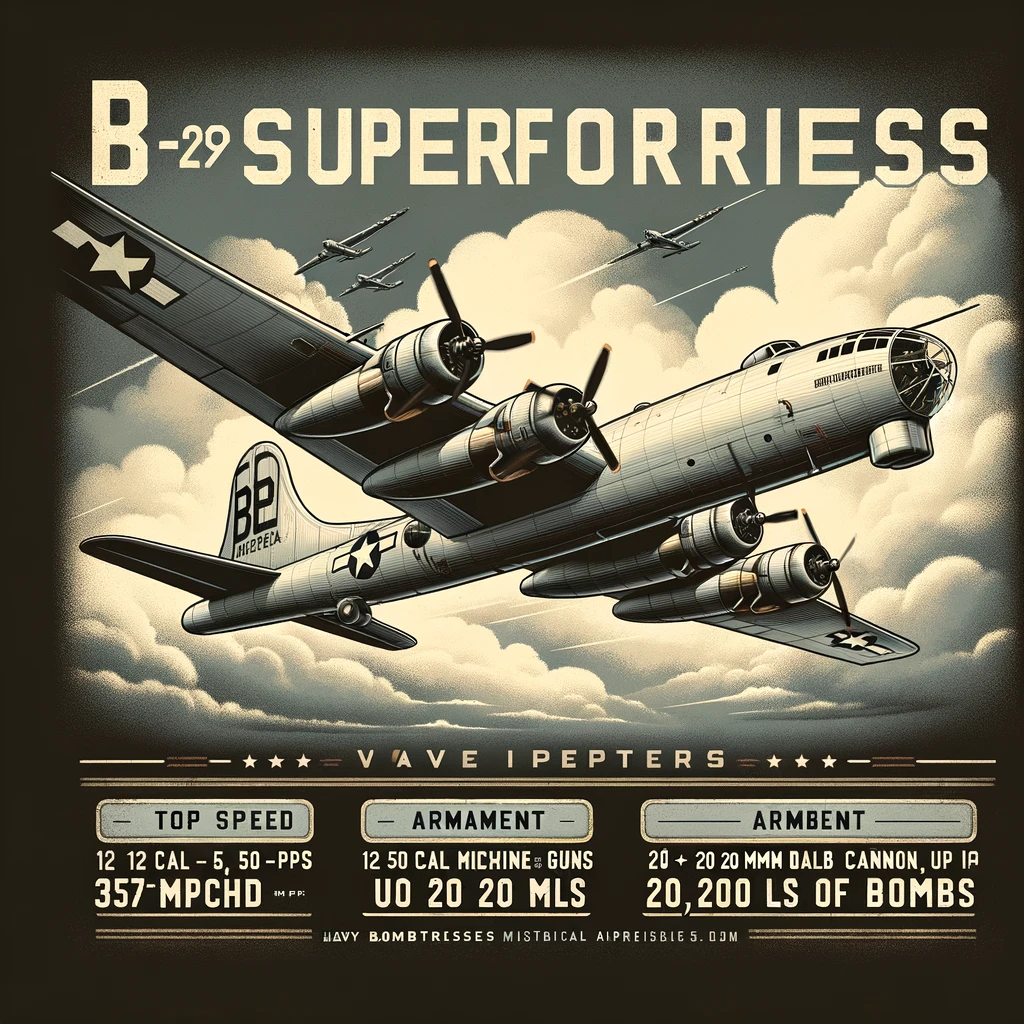
History and Production:
The Boeing B-29 Superfortress is a technological masterpiece of its time. Its manufacturing was started back in the year 1942 and 3,970 units were produced during its production. It was designed for Pacific Battlegrounds to have long-range & high-altitude bombing missions over Enemies.
Operational Achievements:
The B-29 without a doubt best known for its Atomic Bombing, as it was the U.S. Army Air Force Bombing plane that dropped the atomic bombs on Hiroshima and Nagasaki. These operations in the Japanese homeland, the middle point of the Pacific battlegrounds created a crucial turning point in the war.
Cost to Manufacture:
However, the B-29 was the Most Expensive Bomber Plane owned and used by the U.S. Army Air Force in World War II, as the cost for a one-unit was about 639,188 Dollars at that time.
American Bombers Of WW2: B-32 Dominator
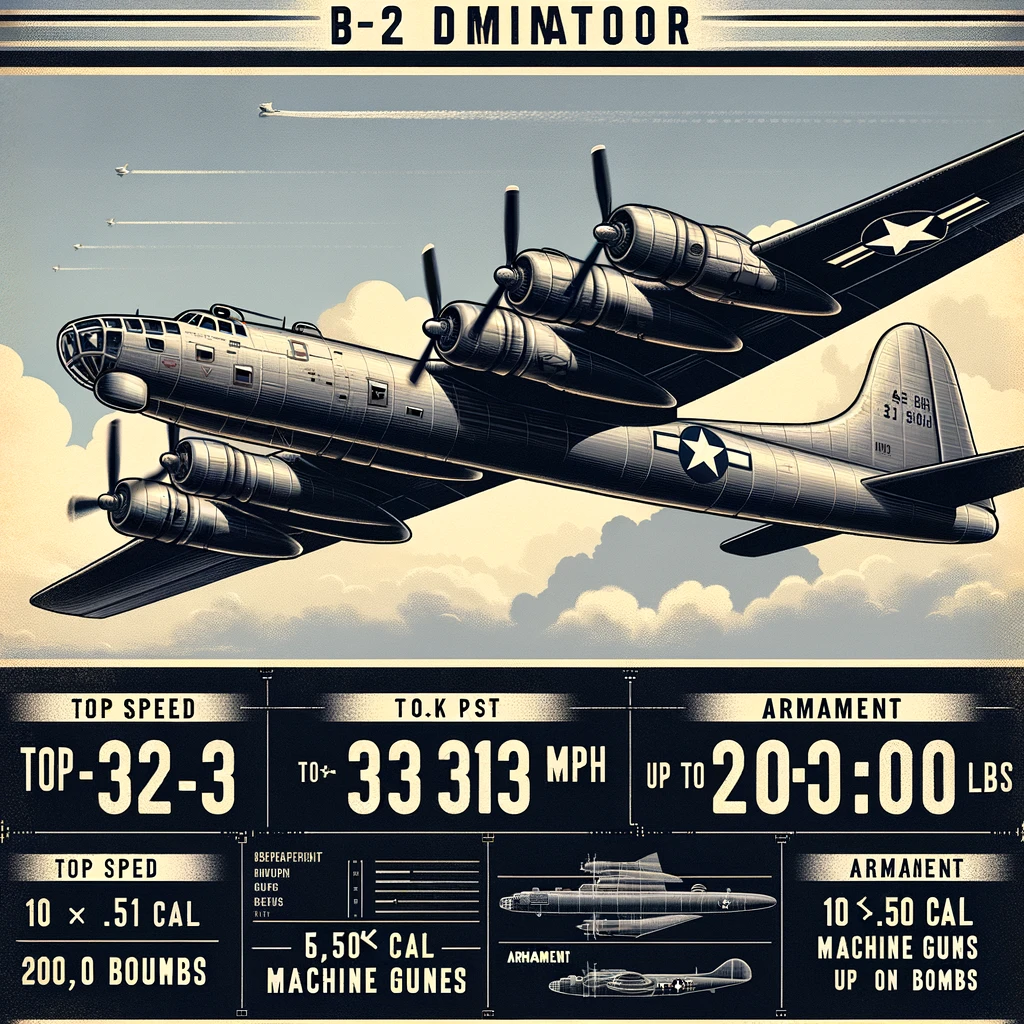
History and Production:
The B-32 Dominator was invented as a backup to the B-29, but it was used in the last stages of the war after a short period of bombardment on Hiroshima and Nagasaki by the B-29 Bombers, the war ended. Only 118 Units of B-32 Dominator were manufactured at that time.
Operational Achievements:
The operational service life of the B-32 Dominator was short as it only had a few missions flown over Japan, so its contribution to the war was less than any other U.S. Army Air Force Bombing plane.
Cost to Manufacture:
The cost breakdown for the B-32 is not so closely documented – instead, the development and production of the B-29 aircraft shadowed them.
ALL American Bombers Of World War Two:
| Aircraft Model | First Flight | Number Built | Unit Cost (Approx., 1945) | Notable Achievements |
| B-17 Flying Fortress | 1935 | 12,730 | $238,329 | Daylight strategic bombing of Nazi Germany |
| B-24 Liberator | 1939 | 18,482 | $297,627 | Long-range missions, Ploesti raids |
| B-25 Mitchell | 1940 | 9,816 | $142,194 | Doolittle Raid, versatility in roles |
| B-26 Marauder | 1941 | 5,288 | $192,426 | Lowest loss rate, precision bombing in Europe |
| B-29 Superfortress | 1942 | 3,970 | $639,188 | Dropping atomic bombs, long-range bombing in the Pacific |
| B-32 Dominator | 1942 | 118 | Not extensively documented | Limited use in WWII, back up to the B-29 |
Axis Bombers of WW2:
The Axis powers of World War II, led by Germany, Italy, and Japan, proved their technological progress by designing some of the engineering beasts of that time, These advanced Bombers were used in crucial parts of the World War II battlegrounds. Let’s discuss details about the top Axis bomber series, their performance, operations, and manufacturing costs.
German Bombers Of WW2: Heinkel He 111
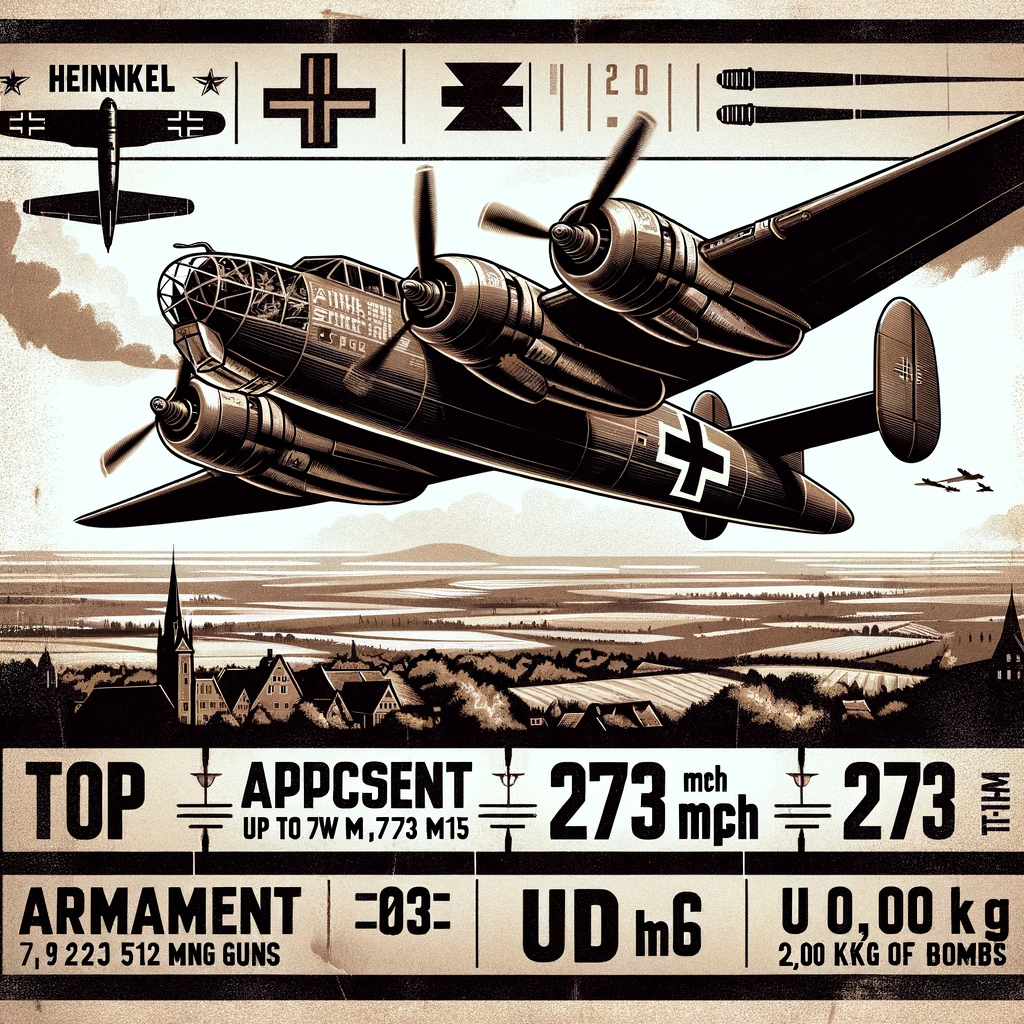
A multitude of bombers that the Germans used throughout the war.
Engineering and Production Cost:
The Heinkel He 111, was designed in the early years of the 1930s, and it was a crucial part of the Luftwaffe’s capacity Bombing. Beside Concealing as a civilian airliner it was a medium-range bomber that could carry a significant amount of cargo.
Production of the Heinkel He 111 overgoes between 1935 and 1944 with almost 7,300 aircraft produced. It had a modified to glazed nose design similar to a greenhouse model, which was the main characteristic of the Heinkel He 111 Bomber.
Operational Achievements:
Heinkel He 111 became famous during the Spanish Civil War and was abundantly used in the Blitz raids against the UK. It was a multi-purpose weapon, capable of playing the role of level bombarding, ground attacking, and anti-ship operations.
Although it was the first and most effective aircraft of Germans, the combat performance & steadily of the Heinkel He 111 deteriorated as the Allied air defenses progressed.
Cost to Manufacture:
The cost of Heinkel He 111 never got revealed to the public, although from the complexity of its design and the strategic raw materials required for its production, such as aluminum and other precision metals, it is obvious that this production was a big venture for Germans.
The labor-intensive nature of Heinkel He 111 production was associated with its design which was not optimized for mass production and therefore was far behind its Allied partners when it came to this particular aspect.
Japanese Bombers Of WW2: Mitsubishi G4M
Japanese Long-Range “Risk–Taker”
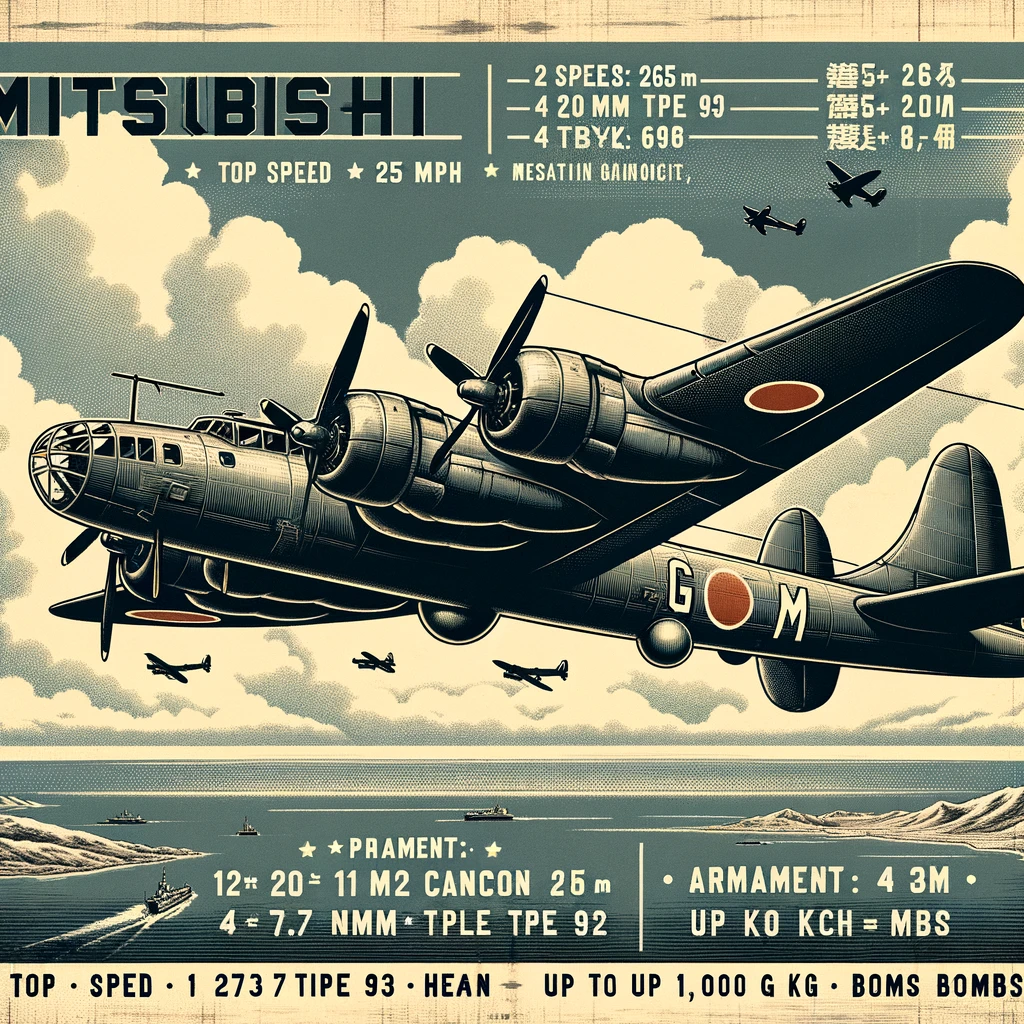
Engineering and Production:
The Mitsubishi G4M, a medium-range bomber, was introduced by the Japanese Navy in 1941, built with long-range and high-speed capabilities, which able it to outrun enemy fighters in the battleground. It was the first military aircraft that could operate far from its home bases, which was crucial for the extended coverage of the Pacific battlegrounds of World War II. It became known as ‘Betty’ to Allied forces, over 2400 units were produced by the Japanese during World War II.
Operational Achievements:
Mitsubishi G4M participated in the Pacific battles like two famous ones, the attack on Pearl Harbor and the sinking of the British battleships Prince of Wales and Repulse. The notorious mission of Mitsubishi G4M was the one that ended the life of Admiral Isoroku Yamamoto when his convoy was intercepted and shot down.
Cost to Manufacture:
Nevertheless, the price of the Mitsubishi G4M, & its maintenance costs remain unknown. However, there are flaws in its design, as it has large fuel tanks that give longer range, but less armor to protect them, and the self-sealing technology makes these fuel tanks even worse.
Whenever it got attacked by the enemies, the chances of its fuel tank catching fire were higher than any other model of that time.
The Mitsubishi G4M highlighted the strategic priority of the Japanese army, which was focusing on range, over any defensive capability.
WW2 Italian Helmet: Fiat BR.20 Cicogna
Italy’s Contribution to World War II
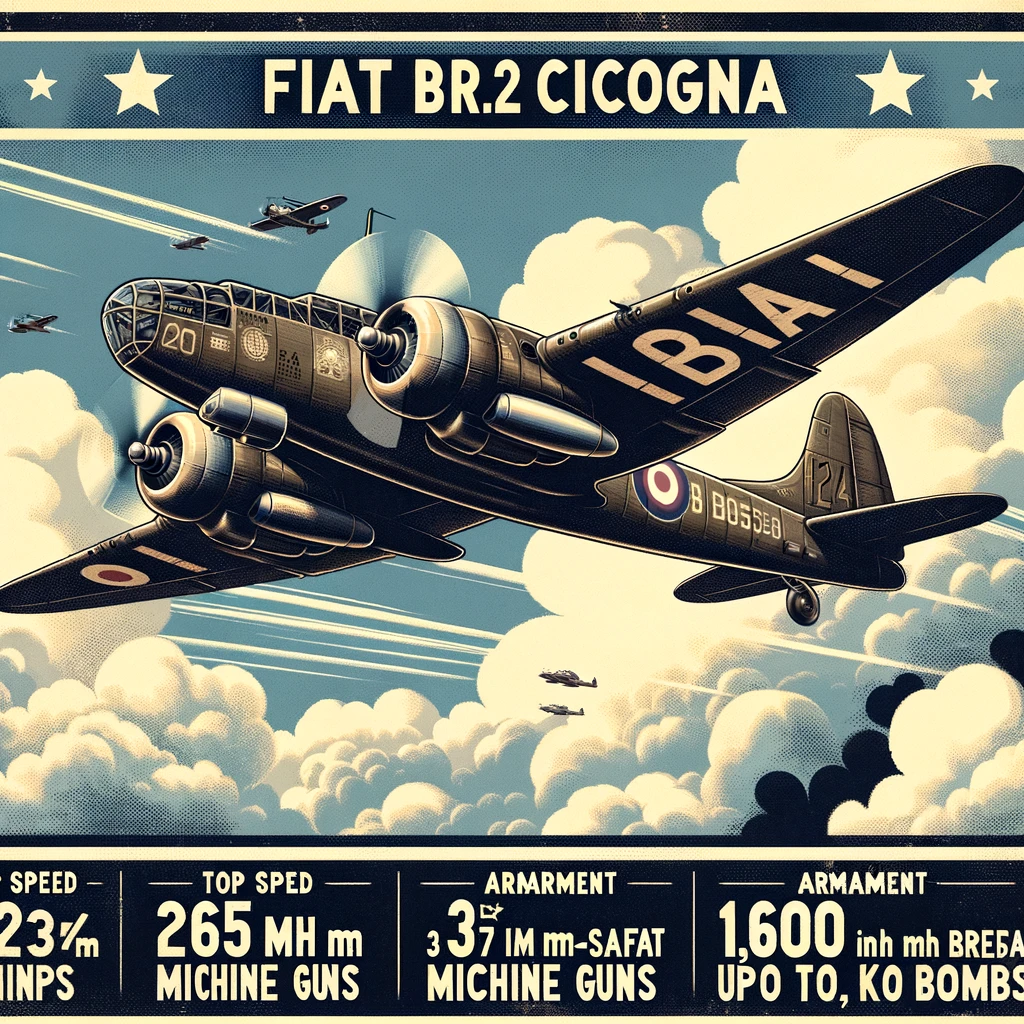
Engineering and Production:
The Fiat BR.20 Cicogna – a medium-range bomber was Italy’s standard model of bomber by the time of World War II. Its first flight took place in the year 1936. When launched, it was considered to be a very well-equipped Bomber Aircraft, but with the progression of the war, it became obsolete. Nearly 500 units of Fiat BR.20 Cicogna were manufactured for different operations like bombing, reconnaissance, etc.
Operational Achievements:
Fiat BR.20 Cicogna was deployed at the beginning of the war in the aerial conflict Battle of Britain and the Mediterranean. It was also dispatched to the East to help the Germans at war with the Soviet Union. The Fiat BR.20 Cicogna bomber only had modest operational success due to its slow speed and its limited defense capabilities.
Cost and Manufacture:
The Fiat BR.20 Cicogna as with other Italian aircraft, was hindered by weak engines and a lack of modern technology due to the industrial downfall of Italy. The total production across all variants of the BR.20, including those sold to Japan and other countries, reached 602 units.
However, detailed financial records specifying the unit cost or overall program cost were not revealed to the public.
Learn About World War 2 Aircrafts Used By American & Axis
